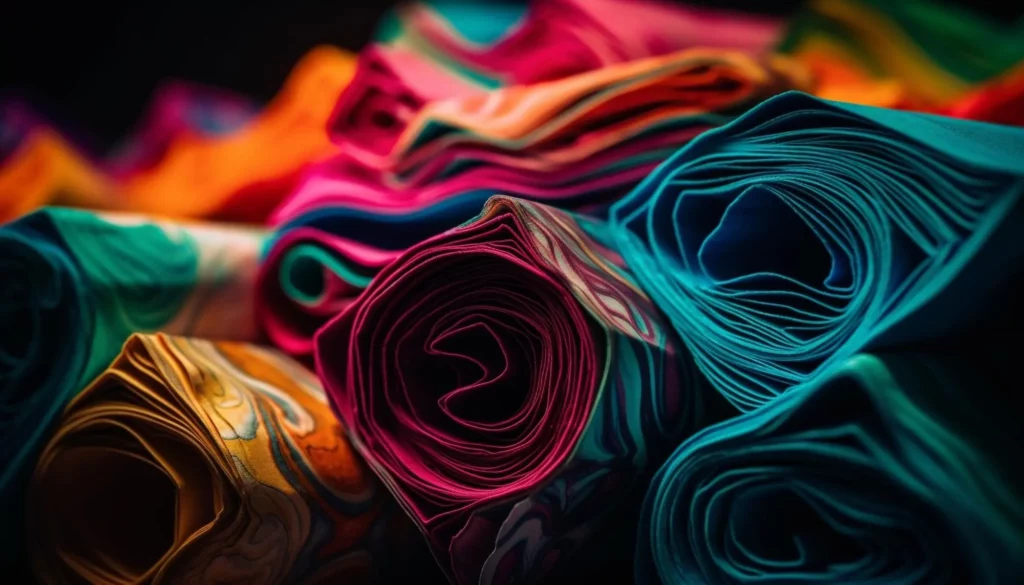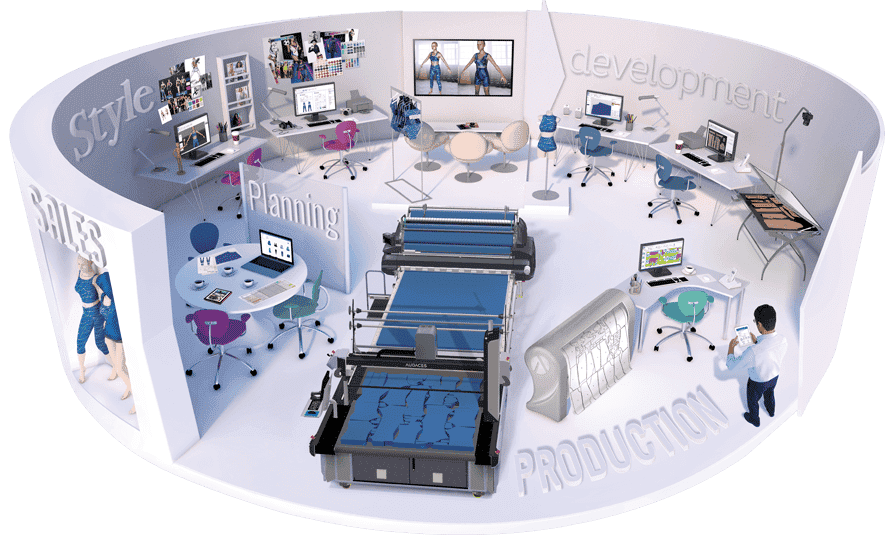Summary
- Calculating fabric consumption helps make the pricing of a garment viable.
- This activity can be done either by using a spreadsheet or by utilizing software.
- Optimize the management of your collection for free with the Audaces360 multisolution!
One of the most important aspects of a collection is the cost it will have to be produced, as this cost significantly affects the company’s profitability.
That is why it is essential to anticipate costs at the design stage, so you can predict the viability of the garment, such as calculating fabric consumption, even before you develop it.
Knowing the yield, length, and perimeter of the cut is crucial, so you can draw up a table with all the information you need to calculate the cost of fabric consumption and other materials.
Find out how to calculate your collection’s fabric consumption. Enjoy your reading!
Sumário
How to do fashion consumption calculation in your clothing production?
Calculating fabric consumption in clothing manufacturing optimizes resources and ensures that you purchase the right amount of fabric for your project.
There are several ways to calculate fabric consumption:
Project and pattern
First, you need to have the design of the garment and the pattern that will be used as a reference for production. The pattern will show the individual pieces of fabric that will be cut and sewn together to form the garment.
Pattern analysis
Analyse the pattern and identify the different pieces that make up the garment, such as the front part, back part, sleeves, collar, etc. Each of these pieces will be cut from a fabric sheet.
Measurements and marking
Measure the dimensions of each piece in the pattern, considering seam allowances and any other relevant considerations for the design.
Area calculation
Calculate the area of each piece by multiplying the length by the width. For example, if the piece is 1 meter long and 0.5 meters wide, the area will be 0.5 square meters.
Total area
Sum the area of all individual pieces on the pattern to obtain the total fabric area needed for the garment.
Cutting efficiency
Take cutting efficiency into account when calculating the amount of fabric required. Sometimes, it is necessary to add an extra margin to ensure there is enough space to cut the pieces efficiently.
Add safety margins
Add an extra margin for adjustments, errors, or other variations that may occur during production. This helps ensure that you have enough fabric.
Fabric purchase
Based on the final calculation, purchase the necessary fabric for garment production.
Learn more: Discover how to reduce costs in wholesale clothing production
Factors to consider in fabric consumption calculation
You should consider some factors to calculate the fabric consumption required for the desired garment more accurately.
It is recommended to create a prototype or initial sample to validate calculations before mass production. Consider these factors:
Garment measurements
When calculating fabric consumption, it is crucial to have precise measurements of the garment to be manufactured. This includes length, width, height, circumference, and any other relevant dimensions.
Measurements should be obtained according to the pattern of the garment or the specific design you are following.
Seam allowances
Seam allowances are additional areas of fabric included to allow for sewing the pieces together.
Usually, seam allowances range from 0.5 to 2 centimetres, depending on the type of sewing and the pattern. These allowances should be considered when calculating fabric consumption, as they affect the final dimensions of the garment.
Learn more: Learn how to use sewing darts in clothing manufacturing
Fabric variations
Fabrics can vary in terms of elasticity, texture, weight, and patterns.
It is crucial to consider these variations when calculating fabric consumption. For example, stretchy fabrics may require less fabric than non-stretchy fabrics for the same garment due to their stretch capacity.
In addition, complex patterns may require more fabric to ensure proper matching.
Learn more: Uncover the fabric composition chart and the most utilized types
The basic formula for calculating fabric consumption

This basic formula helps calculate the amount of fabric needed to produce a certain number of garments, considering cutting efficiency and waste that may occur during the manufacturing process.
These factors may vary depending on the project’s complexity, fabric type, fabric variations, and the specific practices of your production. Practice and experience will help refine these factors to better suit your situation.
To calculate fabric consumption in a basic way, you can use the following formula:
Fabric Consumption (in square meters) = Area of One Piece (in square meters) × Quantity of Pieces × Cutting Efficiency Factor × Waste Factor
Understand the meaning of each variable in the formula:
Area of one piece (in square meters)
It is the fabric area needed to produce a single garment. To calculate the area, multiply the length by the width of the piece.
Quantity of pieces
It is the total number of garments you plan to produce.
Cutting efficiency factor
It is a factor that considers the efficiency of cutting fabric. Typically, it is a value between 1 (100%) and 0 (0%). For example, if you think you can use 90% of the fabric without waste, the cutting efficiency factor would be 0.9.
Waste factor
It is a factor that considers fabric waste that may occur during the cutting and sewing process. It is also a value between 1 (100%) and 0 (0%). If you estimate that there will be 10% waste, the waste factor would be 1.1.
Learn more: How to set up a profitable online swimwear store
How to optimize the fabric consumption calculation?

Consider using specialized cutting software and spreadsheet templates to help optimize the calculation of fabric usage.
Know these two methods:
Use of cutting software
Cutting software is a specialized tool designed to optimize the layout of garment pieces on fabric, minimizing waste and maximizing cutting efficiency.
They can consider fabric patterns, garment pattern pieces, and sizes of pieces, among other factors.
They allow importing the garment pattern, defining sizes, specifying seam allowances, and other relevant details. Then, they generate an optimized layout for cutting on fabric, minimizing waste.
Spreadsheet templates
Spreadsheets can be a useful tool for calculating fabric consumption. We have separated some steps to create a basic spreadsheet template for fabric consumption calculation:
- Piece name
- Length (in meters)
- Width (in meters)
- Piece area (in square meters)
- Quantity of pieces
- Total area (in square meters)
- The formula for a piece area
- The formula for the total area
- The formula for total fabric consumption
This spreadsheet approach can be manual, but is still an effective way to calculate fabric consumption, especially for simpler projects or to quickly assess the amount of fabric needed.
See how Audaces360 helps calculate fabric consumption for your manufacturing

We created Audaces360, a complete solution for you to generate more results, optimizing creative talent and resources through information and practicality.
In the fashion industry, companies face the significant challenge of balancing design assertiveness and production profitability. Audaces360 is the ultimate platform you need for your business to meet and overcome this challenge.
Precise calculation of fabric consumption
With Audaces360, you will have access to a powerful tool that calculates fabric consumption accurately, allowing you to save material and reduce costs.
Seamless integration
Audaces360 integrates all stages of the process, from design conception to final production, creating an efficient synergy that saves time and resources.
Maximization of creative talent
By automating repetitive tasks, Audaces360 allows your creative team to focus on what they do best: creating amazing and innovative designs.
Measurable results
With Audaces360, you will have access to metrics and reports that will help you make informed decisions and drive your business growth.
Guaranteed profitability
Thanks to the efficiency and precision of Audaces360, you can achieve a perfect balance between design and production, making your company more profitable.
Don’t let uncertainty in fabric consumption calculation harm your manufacturing. With Audaces360, you will have total control over your processes and stand out in a highly competitive market.
Optimize your fashion production! Download the calculator and maximize your profits now:
FAQ
Fabric Consumption (in square meters) = Area of One Piece (in square meters) × Quantity of Pieces × Cutting Efficiency Factor × Waste Factor
Consider using specialized cutting software and spreadsheet templates to help optimize the calculation of fabric usage. This can help reduce waste and improve efficiency in your production process.
There are several ways to calculate fabric consumption: project and pattern, pattern analysis, measurements and marking, area calculation, total area, cutting efficiency, added safety margins, and fabric purchase.










